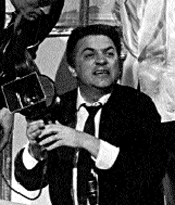|
Anita Ekberg on the set of 1960's La Dolce Vita, photographed by Pierluigi Praturlon |
|
The bitter sweet life They were the glory days of Italian cinema, immortalised by a man with a camera who roamed the sets, gaining unrivalled access to the stars. John Hooper pays tribute to Pierluigi Praturlon
What few cinema-goers realised was that the scene in the film was a reconstruction of a real event. Two years earlier, Ekberg had spent the evening with a set photographer, Pierluigi Praturlon, at the Rancho Grande nightclub in Rome. To ease her aching feet on the way home, she climbed into the fountain. Praturlon, who never went anywhere without his Leica, lit up the scene with the headlights of his car and caught the moment in a photograph that Fellini later saw in a magazine, Tempo Illustrato.
Though he was often described as a paparazzo, "Pierluigi" (as he was known to all) was nothing of the sort for most of his career. The paparazzi were the bane of celebrities. Praturlon, a cultured man who spoke five languages, was their collaborator and, in some cases, confidant. Sophia Loren made him her personal photographer. Frank Sinatra consulted him about which tapestries to hang in his personal jet. Claudia Cardinale describes him as a "gentleman". Having worked earlier in his career as a photo-reporter, Praturlon was able to bring to the film set a journalist's sense of reportage - indeed, he is credited with transforming the craft of the on-set photographer. Before his arrival, in Italy at least, stars merely posed for stills during breaks in the filming. Praturlon roamed the sets, capturing them as they went about their work. During the filming of La Dolce Vita, he shot an unprecedented 13,000 frames and, as he got to know the stars, had unrivalled access. One of his images is of a half-naked Ursula Andress changing for a scene in the 1972 western Red Sun - it does not appear in the exhibition, but it does in the accompanying book. Praturlon was born in Rome in 1924. He was called up a week before Italy pulled out of the second world war, so after the armistice he became a wanted man for the German occupiers. Indeed, he was captured, but managed to escape from the train on which he was being deported. Back in Rome after the war, Praturlon drifted into photography and, in 1947, he got his first "scoop" when he spotted and photographed the reclusive Greta Garbo on a visit to the Italian capital. A couple of years later, the producer Carlo Ponti brought him on-set. Within a few years, Praturlon's studio had become one of the pivots around which the dolce vita revolved, and he himself was among its leading protagonists. Marcello Mastroianni, Vittorio Gassman, Elsa Martinelli and later non-Italian stars such as Yul Brynner and Marlon Brando all had themselves immortalised by the man nicknamed "Lux" (because he was like the soap which, according to an advertising slogan then, was "the choice of nine stars out of 10"). With hindsight, it can be seen that 1960, the year of La Dolce Vita, was the high point of Praturlon's career. It was also the year Praturlon took another of the most famous stills in Italian cinema history, showing a weeping, crumpled Sophia Loren as the rape victim in Vittorio De Sica's Two Women. The last major film on which he worked was Fellini's Ginger e Fred, which was released in 1986. Praturlon's final years were sad - a downward spiral of drink and depression that ended with his death in 1999. By that time, few people had much idea of the role he had played in capturing the heyday of Italian cinema. One who did was Claudia Cardinale. "Looking at Pierluigi Praturlon's photos and reflecting upon them," she writes of him, "is to relive a glorious, but irretrievably lost, era on which I cannot but look back with a touch of pride and regret." · Pierluigi. On Cinema is at the Galleria Photology, Milan, until September 8. The exhibition catalogue is available from photology.com at €65.
|
 It
was a moment that marked a turning point in postwar Europe: Anita
Ekberg wading through the Fontana di Trevi in Federico Fellini's film
La Dolce Vita, as improbably voluptuous as the fountain itself. La
Dolce Vita was shot in 1960, and while Ekberg's low-cut, dark evening
dress may look back to the formal 50s, her insouciant transgression
points unmistakably ahead, into the subversive 60s.
It
was a moment that marked a turning point in postwar Europe: Anita
Ekberg wading through the Fontana di Trevi in Federico Fellini's film
La Dolce Vita, as improbably voluptuous as the fountain itself. La
Dolce Vita was shot in 1960, and while Ekberg's low-cut, dark evening
dress may look back to the formal 50s, her insouciant transgression
points unmistakably ahead, into the subversive 60s.